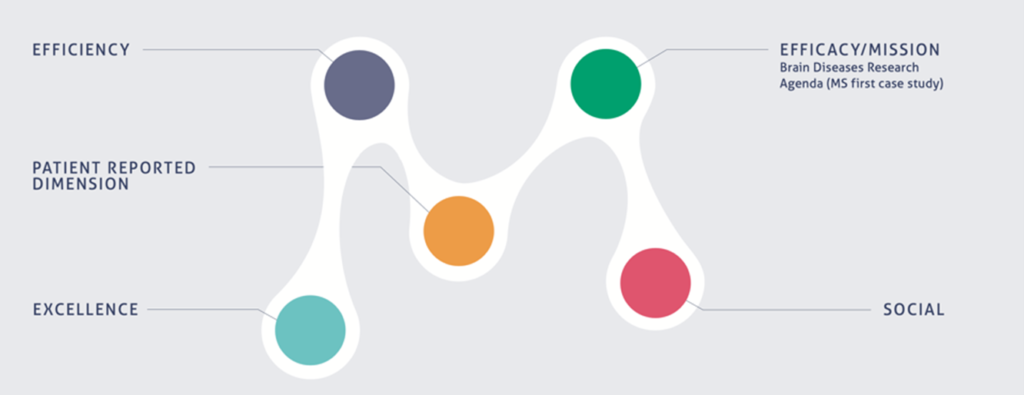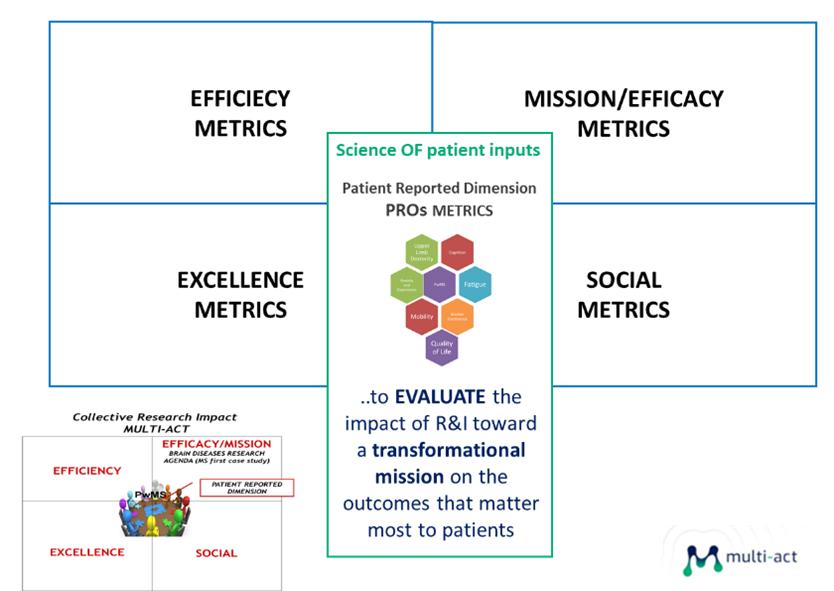Could co-accountability be used in research to impact the outcomes that matter most to patients and society?
Does health research and innovation impact patients? How are we currently measuring this?
At present, the impact of research and innovation (R&I) is evaluated primarily through scientific publications, highlighting its excellence, but not sufficiently demonstrating the impact that R&I has on patients. Patient Reported Outcomes (PROs) – outcomes evaluated directly by the patient and based on the patient’s perception of their disease and its treatments – are used to evaluate the effectiveness of R&I in clinical trials. Could they also be used to assess the impact of R&I as a whole?
What can we do to ensure that we are creating impact on outcomes that matter to all?
To increase the impact of research on patients and society, the evaluation of health R&I must move beyond conventional metrics measuring financial return or research publications. Only considering these measures is not enough because they focus only on part of the effects of health R&I. In contrast to this approach, health R&I need to be targeted, designed, implemented and evaluated taking into account the plurality of the interests and perspectives of multiple stakeholders involved in the research. Moreover, the patients’ voices and needs should matter throughout the entire research process. Specifically, health R&I should be evaluated through a collective accountability approach. This co-accountability approach requires the development of brand-new tools, procedures and metrics that shows the value generated by health research to society.
To achieve this purpose, MULTI-ACT has developed a model, known as the Collective Research Impact Framework (CRIF). It allows the effective cooperation of all the key actors involved in the health research field. It particularly relies on the direct collaboration and continuous dialogue among researchers, patients, patient organizations, pharma industry, and other relevant stakeholders to develop and implement a novel evaluation framework that suggests metrics to evaluate the impact of health R&I across five different but interrelated dimensions: conventional metrics related to the excellence dimension are integrated with new measures related to the economic and financial dimension (efficiency), to the social dimension, as well as to a dimension related to achieving mission success (mission dimension – efficacy; one explicit driver of the MULTI-ACT co-accountability approach). A fifth and transversal dimension is applied throughout the four dimensions of MULTI-ACT model as a tool for investigating the impact of R&I on outcomes that matter most to patients (Patient Reported Dimension (PRD)).
Why is the Patient-Reported Dimension (PRD) at the core of the CRIF?
MULTI-ACT advocates that patients must have a central role in the assessment of the whole health R&I process. The PRD considers patients as the key stakeholders, whose needs, knowledge, experiences and perspectives must be understood and incorporated into the health research evaluation process. Indeed, the PRD is not simply a dimension in itself, but rather it represents a key and transversal approach in which the other four dimensions (efficacy, excellence, social and economic) are rooted. In practice, this means that, although the efficacy (mission), excellence, social and economic dimensions should be evaluated through the context-specific indicators, the dimensions must also consider Patient-Reported Outcome (PRO) measures that incorporate the needs, interests and perspectives of patients.

How does co-accountability make the Patient-Reported Dimension effective?
Co-accountability implies taking an approach that promotes the integration and involvement of relevant actors, and most importantly, patients in the design, implementation and evaluation of health R&I.
For this to be possible, MULTI-ACT is grounded on five co-accountability pillars that guide and support the engagement of patients and other stakeholders in the different steps of the health R&I process. All pillars require dialogue and receiving feedback during the research process. This collective impact assessment process is cyclical and iterative by nature and specifically promotes stakeholder engagement in (1) the definition of research priorities and objectives, (2) the development of an operative Framework, (3) the co-selection of indicators as well as (4) the collection and analysis of data to evaluate research, and (5) the reporting, monitoring and assessment of the health R&I process.
Within this co-accountability approach, MULTI-ACT seeks to guarantee that the needs and perspectives of patients are given the relevance they should have in health R&I. Therefore, the co-selection of indicators is one of the most relevant pillars. It ensures that the perspectives of patients and other stakeholders are considered when defining the evaluation system to be used to assess the impact of health R&I on the five dimensions of the CRIF.

Figure 2. Co-accontability Master Scorecard
This blog was written by: UNITN – Ericka Costa, Michele Andreaus; UBU – Carlos Larrinaga, Nicolás Garcia Torea, Juliette Senn; TAU – Anna Kork; FISM – Deborah Bertorello, Giampaolo Brichetto, Paola Zaratin
This blog entry is a direct continuation of the previous blog, “#6Patient Reported Outcomes: let’s keep patients engaged as key stakeholder in R&I”. Read it here and “#2What is co-accountability and why is it important for multi-stakeholder initiatives?”. Read it here.


